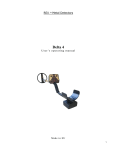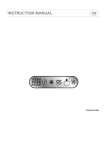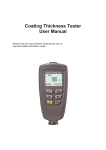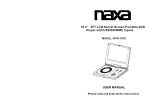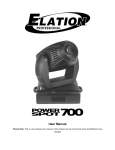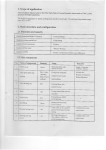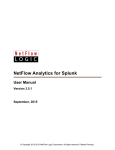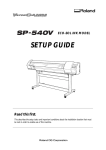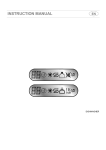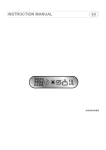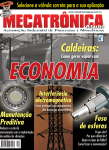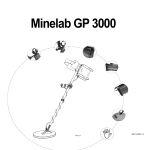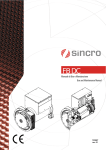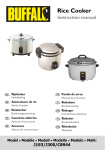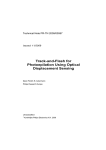Download NRG 150 - Mikron Metal detectors
Transcript
NRG 150 Us er ’s o p era tin g man u al Made in B ulgaria 1 In order to use the device for a maximum long time and without problems, as well as to be able to use all of its options, please read carefully the whole instruction manual and observe the directions in it. Your NR G 150 i s shipped w ith thes e parts: - Upper Pole Ass embl y – f ull y a ss embled, includi ng upper pole ste m with handle grip - Middle p ole asse mb l y with pole loc k - lower pole - mad e of plastic in orde r to not dis turb the work of the coil. - 27 c m D D search coil - electrical set box – made of extre mel y strong p lastic, including 8 AA al kaline batteries or 10 rec hargeable acc u mul ators NiM H 1,2V/ 2 800 mAh. - 220V aut o matic c harger - Operation user’s ma nual Warranty card If an y of t hese it ems are mi ssing, immediatel y inf orm us or our auth orized dealer where yo u p urchased yo ur dete ctor. Asse mblin g the NRG150 is si mple a nd you don’ t need an y special tools . Just mount the s earch coil on the lower pole asse mb l y, connect the pole asse mbl ies togethe r, adjust the pole length , wra p the e xcess cable a roun d the pole and plug the cable into the cont rol unit. Finall y ad just search coil an gle to yo u r pref erence an d yo u are rea d y. NOTE: Do not all ow the cable to f lop loosel y over th e search coil. Sinc e the detector is sens itiv e enough to „ see“ the tin y wires in t he cable, a f lopp y cable can cause false signals as the search coil senses the mo ving wires. 2 C ON T RO LS: NRG 1 50 c o n tro l p an el: - “GROU ND BA L ANCE ” – eli minat es the signa ls of the ground mineraliz ation . - “DISC” – regulat es degree of eli min ation of iron and u nwanted ob jects. - “THRE SHOL D ” – used f or adjustin g sound le vel and r egulates dep th of . - “ON / V OLUM E ” – switche s on the detector and adjus t sound lev el - “SAT S PEED” - (Self Adjust ment T hreshold) SAT Sp e ed – adjusta ble rat e beep on dete ction of metal ob jects. - Button “ Auto G E B” – turns on and off automat ic grou nd balance. - Button “ LIGH T” – switch o n and s witch of f LCD backlit. - Jack “Pho nes” – used f or head phon es (one 3,5 mm on t he f ront panel, and one 6,3 mm. on the bot t om side of the box ) 1. Asse mbling of the devi ce: The bearing rod i s asse mbled b y i nser ting of the lower part into the upper one. Choo se the d esired lengt h of the whole co nstructi on and the f ixing cla mp is tightene d betw een both part s of the bearing r od. The lower p art of the bearing rod is put with the o pening b etween the e ars of the coil an d the p lastic bolt is tightened b y choo sing the p osition of the coil to be parallel to the ground surf ace. The coil cable mus t be wind up tightl y around the bearin g rod and is switch ed to the socket of the b ox with electr onic. Upon switc hing o f the 3 cable of the coil to the socket on th e box, tighten the well the metal nut of the coupling to the t erminal of the box. Upon switchin g off , unscrew the nut co mpletel y and pu ll out t he co uplin g witho ut pul ling or twisti ng th e ca ble of the coil. This wa y, yo u will prev ent the cable and the conductors i n it f rom breakdown or short circuit. The searching coi l is approached to t he surf ace of earth b y pa yi ng attenti on to avoid prese nce of met als within its r ange. NOTE: Detect or ma y not work a s ex pected ind oors du e to the high degr ee of met als used in mo dern construc tion. It is best to tune a nd practice out doo rs to ensure stabl e, pred ictable r esul ts. 2. Sw itch on and w ork w ith NRG 1 50. 1. Turn the “ ON / VOLUM E ” knob to “ ON” and a dju st pref erenc e volu me of sound. The displa y w ill mo mentaril y s how an o penin g screen whi ch lis ts the sof tware version. 2. Settin g the “T HRESH OLD ” - While holdi ng the d etector a f ew f eet above ground and aw a y f ro m an y metal o bj ect, slowl y tur n th e “THRESHOLD ” knob until yo u hear a ve r y slight audio ton e through the spea ker or h eadphon es. This is the opti mu m se t -point f or the “T HRESH OLD ”. If the search co il is not in mo tion an d not cl ose to metal, the detector sh ould b e silent. A light “ buzz” adjust ment is r eco mmende d to insure opti mu m de pth and ma xi mu m perf ormance. As “THR ESH OL D ” is in l ow po si tion, as lo w is s e nsitivit y. Too lo w of a threshold setting ma y cause ver y w eak signals to not be heard. Too hi gh of a threshold s etting m a y c ause ope rating instabilit y. 3. You can work in ma nual or in auto mat ic “ GR OUND BALANC E ” mo de s: - In man ual gro und bala nce mode: Search f or and se l ect a clear piece o f ground or san d t hat does not con ta in an y met allic targ ets. Wit h the co il elev ated at least waist high and a wa y f rom an y met allic targ et, slo wl y adjust the TH RESHO LD contr ol until a ver y f aint audio threshold s ignal is heard. 4 Lower the se arch coil to with in one - inch of the gr ound surf ace while list ening to the threshold audio signal. If the threshold sig nal is high tone , the “GROUN D BAL ANCE ” contr ol needs to be decreased (rotate c ounter clockwise). If the threshol d sig nal is low tone , the “ GROUN D BA LA NCE ” control need s to b e increased (r otate clockwise). Keep repeating th is step until threshold si gnal is the sa me wit hin one-inch of the gr ound as it is i n th e air. Once this is acco mplished, the detect or is properl y ground balanced . Wh en th e gro und mi neralizati on is r ejected, t h e det ect or can see d eeper t argets, and is less suscepti ble to grou nd inter f erence. Wh ile balanci ng t he detector, you h ave to be sure the re are no metal o bjects around the se arch coil. If it seems di ff icult or imp ossib le to get little c ha nge in the stead y thre sho ld as t he coi l is l owered, yo u ma y be atte mp ting to t one on top of a peace of metal . Move to a diff erent spot on the ground and r epeat balancing. Once th e initial gro und ba lance is co mpleted , the detector is re ad y to be used. 2 - 20cm. Fig. 1 A proper adju st me nt of the manua l ground balan ce wi ll enable a little mo re depth over auto ma tic ground bala nce . However, an i mp roper adjust ment o f the ma nual groun d b alance could and in all probabili t y decr ease the depth perf orman ce of the me tal detect or gre atl y . - In auto matic gro und bala nce mo de: push the b utton “Auto GE B” and yo u will he ar a bee p . The ,,GROU ND B ALANCE ” knob d o not have to be tu rned on at that ti me!! If yo u sw eep the sear ch coil over non-f errous metals (gold, silver, cop per, bro nze) a high-ton ed sou n d can be heard; a nd if you sweep o ver f errous metals a low sound is heard . Without th e abilit y to cancel ground mi neralization, a met al detector cou ld resp ond to mi neralizati on as if it where a good target. 5 Alwa ys tr y to ma n ual balance to the ground surf ace , an d if it see m dif f icult or impossibl e to get little change in a stead y thr eshold as coil is lowered, we reco mmend use “ A uto GE B” reg i me. Use “ Auto GEB” when yo u f ind yo urself in a situati on th at does no t allo w manual ,,GRO UND BA LANC E ” to be adjusted cor rectl y. The ground cond i tions are reall y ba d with mineralize d ground, hot rocks and iron trash, so your sweep spee d must be reduced f or best results. “Auto GE B” is recommended when searching in wet salt sand too. NOTE: U nder s o me severe mineral condition s gro un d balanci ng may not be possible. The best result you will get if searchin g when t he soil is d ry. Fig.2 NRG 15 0 work ing in d yna mic regi me - searc hing m etal objects is ma de b y mo ving sea rch coil toward gro und sur f ace – f ig.2 , f ig.3 Wrong Correct Fig.3 Start swingin g the search coil in wide sweeps that overla p each other, as ne ar to the ground surf ace as possible -Fig. 2 The search coil should not touch the ground dur ing yo u r sweep. T he pole length s h ould be adjusted t o allow this without ha ving to l if t the detector with yo ur elbo w or sh oulder. The search coil should res t about one inch ab ove the ground w hile yo u are standin g erect . The angle of the search coil should allow the botto m to be p arallel to the groun d. 6 If you expe rience f alse signals or co nstant beep ing or popping a nd you a re not near co mmon sour ces of electrical in terf erence, push " Auto G EB " to s wi tch on auto matic balanci ng and/ or red uce Threshold (coun te rclockwise) slig htl y and tr y again. As a s earch c oil i s swept o ver the gro und, ign ore th e dis pla y and conce ntra te on the sound the dete ctor makes. A s a search coil is p ass ed over a metal t h at is likel y iro n tras h, t he sound will be l ow tone (245 Hz). Once f ami liar w it h the sound t ypi cal iron produce, an oper ator ma y pa ss ov er such targe ts wi thout consulting the disp la y indication, and continue se archin g, saving more time. As a searc h coil is passed o ver a met al that is likel y go od, high tone s oun d will be heard (7 00Hz). A good tar get t yp i call y produ ce a lo nger, more solid s ound, no partial sig nals and mixed sig nals: high-low ton e. On ce a s mooth sol id signal is heard, swee p th e search coil over the ta rget several ti mes and look a t the displa y ind ication. Wh en a metal targ et is detected , pro bable target t ype will be indicate d at the top of the LCD screen. The Upper Scale, whe re the VDI curs or is illu minated w hen hunting, cons ists of eight (8) graphical seg ments f or mo re precise Targe t ID a nd discri mination. - First seg ment in di cates the metal i s l i kel y iron or st eel , such a nails, steel bottle cap, or iron relic. At the sa me time, the sound is low tone (if not switch on IRON MASK mode). Dig if onl y ir on/steel is of interest. - Second se g ment i n dicates of s mall f oils. Howev er, so me ver y s mall gold jewelr y can also b e indicated b y th is segmen t. You ma y want to dig this target in areas whe re s ma ll gold jew elries ar e suspected . - Third se g ment in dicates s mall gol d coins, ri ngs, me diu m jewe lr y, and small anc ient c oin s. The most desire d metal - gol d, us uall y d is pla yed in this seg ment . H owever, large and s olid f oils can be in dicated b y this se g ment t o o. - Fourth seg me nt in dicates most likel y old bronze coins, me diu m to larger gold jewel r y or go ld coins. Howeve r, alu minu m pull ta b can also be in di cated b y this seg m ent. 7 - Fifth seg me nt ind icates mediu m cop per or zinc coi n, or large alu minu m screw caps. So met ime s, a large gold rings or coin s ca n be indicate d b y this seg ment. - Six th and sev enth seg ment mos t of ten indicat es s mall silver coins, also big bronze or copp er coins. - Eight se g ment al most alwa ys indica te s high p urit y s ilver , big sil ver coin s, but so met i mes, o ld big bronz e coins a nd other it e ms of b ronze with out i mp urit y. Each of the 8 seg ments operate s indepen dentl y. It can 't be dis pla yed si multaneo usl y tw o or more s eg ment s. Of ten when detecting ver y ol d rust y iron objec ts and some iron wit h impurities of nonferrous metal such as galvanize d ste el, or iron b ottle caps, indication on the 1-st row ju mps f rom th e f irst to the last seg ment, an d vice versa. This is alw a ys a signa l that is detected magneti c object. Such ite ms of dubious an d mixe d signals more accu ratel y identif ied as iron, if yo u detect with the edge of a searc h coil than if you a re just belo w the c enter of the coil. Highl y mine ralize d soils have a grea ter impact on the d etector and thus t h e accurac y of VDI . In high mineral iza tion detec ted si gn als can be cha nge d with graphical and digi tal indicatio n, tha n when teste d in a ir or in low miner alized or sand y s oil. U sua ll y such p laces V D I is shif ted to the l ef t. For exa mple, i f one nor mal metal o bjec t is det ected with t he "sign " of the f o urth or f if th segme nt, if buried in such mineralized groun d, indication ma y be the second or third seg ment. S o whene ver in doubt of the displa y, che ck the detected obj ect, a nd so over ti me you will learn to so me ext ent to recognize w hat has detected met al detector! Wh en a me tal targ et is detecte d , аlon g with the VDI cur sor of the f irst row , yo u can se e their co mmon VDI n u mb ers (0 -9 9), on the botto m row o n the screen. “VDI = “. VDI (Visu al Dis cri mination Indic ation) is a di git al indication whi ch depends on the me tal targets exact a llo y, size, and s ha pe. The ref erence label below t he di spla y provide s a co mpa rison of kno wn t a rgets an d thei r co mmon VDI nu mbers. Dif f erent meta l targe t s ma y share t he sa me VDI nu mbe rs based 8 on their electr ical characteristic s. V DI nu mbers f ro m 0 to 99 are ava ila ble and cover the ent ire ra nge of allo ys and s izes. Wh enever detectio n of met al obje ct s, initiall y conce n trate on t he sou n d signal, so yo u can better deter mine th e exact locati on of the object. 3. “DI SC” knob is used to eli minate an y ta rget t hat yo u do not want t he detector to a udibl y respond to . If yo u need to el imi nate more f err ous metals over t he ground, the “ DISC” control must b e se t in a position ov er “ Rings” or “C o ins”. If you co me upon non-f errous me tals /gold, silver, copp er, bronze/ a high sound can be heard ; and if you co me upo n f errous metal a low sound is heard. If the “DISC” control is in low positi on - “ Iron”, e ver y f erro us object will be s ignalized wit h hig h tone (like non – f errous ). If the soil i s too mineralize d we re co mmend the “ F oi l” or “Iron” pos ition. So me tras h metal s such a s pieces of lead , tin, cann ikin or p ot metal wil l produce a g ood so und regardle ss of the DISC position. 4. IRON MASK m odе. Wit h the trigger o n the hand grip in the f orward position, yo u can switc h on IRON M ASK mod e. Indication that yo u will see the displa y - t he f irst se gment will be blacked out with the s ymbol I RON MA SK . Wh en you swi tch on this mode , w il l be disabled low t one on detectio n of a ma gnetic metal. This mode is pr ef erable when w orking i n area s heavil y conta minate d with iron trash . I RON M ASK sym bol V DI cursor 9 Note: If the poten tio meter " DISC" i s reduced t o a min imu m, the detector will detect f errous ( magnetic) objec ts with high to nes, but will not di sp la y a n indication of the t yp e of metal, as i t would be the f irst seg men t, and in this mo de it is indicat ed b y a s ymbol f or IRON MASK . T heref ore it is preferable when use mode IR ON MASK , poten t io meter " D ISC" t o be increased to at least position F OIL or mo re. Wh en sw itch of f mo de IR ON MASK , i.e. r eturn the trigger in the middle position, the detec tor will work agai n in t he Tw o To n e mode - hi gh to n e f or non-f errous metals and low tone f or f errous metals . At the sa me ti me, will disappear an d the s ymb ol f or IRON MASK on the f irst line of the displa y. 5. Searchi ng : NRG-150 can wor k with 2 search coi ls - 27 cm. and 36 cm. Lar ge 36c m. s earch coils are us ed to d etect large an d bul k y metal o bjects d eepl y burie d to ab out 1. 2 to 1.5 m maxi mu m, and a s mall pr obe is used to det ect and preci sel y locate single coin depth o f abo ut 30-40cm. o r a large metal obj ects at depths up to 1 to 1.20 m (depe nding on s ize). Also, s mal ler co ils c an b e used in bushes, bu mp y and uncomf ortable search locati on where it is i mpossible to use large coils. The greater the s ize of the search coil, the greater will be the depth of detection, b ut wit h the increa se of the coil size , will be hard to detect ver y small metal obj ect s. The dif f erence in depth of detection using large c o ils is appreciable f or lar ge metal obj ects s uch as a large met al object is, t he gr eater the dif f erence in d epth of detection b etween lar ge and s mal l searc h coils ! I.e. if the dif f erence in depth of detection o f large and s mall c oils f or me diu m co in is 3-4c m., the dif f erence in depth of detection as metal cup or pot of coins is about 15 c m. Ther ef ore, the use of large coils makes s ense if you look b ulk y ite ms and it is i mp ortant to f ind the best possible dept h. Disadvantage of larger sensors is their si ze, require a f lat and clean places t o look. In conta minated areas with l ots of scrap metal i s advis able to use s maller probes. To test f or stud yi ng the characterist ics of the device, you can make po l yg on where buried vari ous metal ob jects at dif f erent depths. Also you can put to the 10 ground si zes me ta l objects. Move t he search coil a t diff erent heights above the m and yo u wil l learn to e valuat e the size an d de pth of the metal object depending on th e intensit y and d ura tion of the so und. Af ter a while yo u will learn to recogn ize objects that lie just bel ow th e su rf ace or at de pth. For exa mple, the sign al f rom a small o bject located near the surf ace of th e earth will disappear or d ecrease signif icant l y if you raise the coil, while if the object is large, even the deep signal it will hardl y cha nge if yo u rai se the coil. Also, note the dur ation and f requenc y of the sound mode when plug ged Pin Point (VCO). 6. Pinpoi nting a T arget A good method f or pin pointin g is "X -ing" the targe t with the search coil. Re me mber that the target's respons e s ound is al wa ys gre atest when t he targ et is directl y un der the center of the searc h coil. To "X" a tar ge t, squeeze a nd hol d the trigge r located on the h an dle and s weep t he search coil over th e target f ro m si de t o side and then f rom f ront to ba ck u ntil yo u can ident if y th e ce nter of the X — t he spot on the ground whe re the t arget r espo nse sou nd is the gr eatest. U se lou dest tone, displa y lev el indic ation – bars on the 1 s t ro w, to ind icat e targets exac t cen ter. Pinpointi ng a targ et is proba bl y best done b y "X -ing" as well. Re me mbe r that the detector will b eep just as the tar get passes unde r the center of the search coil. Sl owing the s weep spe ed do wn will hel p you pick out t he cen ter of t he X, but reme mber that the search coil mu st alwa ys be moving slightl y f or target detection. 11 Another ea s y met h od is to sweep t he coil f rom side t o side across the tar get in ver y sho rt s weeps as you slowl y mo v e f orward and bac kward acr os s the t arget. Slow do wn th e sw eep rate a nd s hort en the s weeps unt il you just b arel y get a response at o ne spot. The target will be directl y be low the coil center at this response time – f ig.4 Then turn 90 degrees an d swe ep the coil side t o sid e noting the ce nter f ro m this new direc tion. "X" marks th e spot that yo u ne ed to dig. Where the tw o loudest beep in t ersect, is t he cent er of the target. R elease the toggle s witch t o the center positi on bef ore continue to search You can practice with a coin on top of th e ground to beco me acquaint ed with this t echnique . fig.4 7. The det ection depth depe nds o n t he follow ing : -size, shape and l ocation of the object in the soil. The bigger the ref lecting surf ace of the object the deeper it is t o be f ound; -soil co mpositio n and minera lization level – the drie r and more ho mog e neous the soil the easier it will be to ada pt the devic e and f or the device to detect deeper. Under ston es, dr y sand or in cla y ute nsil, metal s are easier to be found than in f reshl y dug out or da mp soil. -the longer the ob j ect has bee n in t he soil the easier it will be to be f oun d as a result of the good contact with the soil. -t yp e of detecting coil. The bigger th e dia meter of the coil the deeper it w ill be able to detec t meta ls. -operator 's experi e nce and skil ls. 12 You can do f ield t ests b y yo urself us ing the device if you bur y dif f erent met al objects in dif f erent depth but yo u sh ould leave th e m in the ground for at least 3 mo nths . T hus th e test results wil l be more reliable. You should mind t he soil t yp e and the moist ure co mposi tion in it. Best result s ar e received whe n th e soil is dr y. Freshl y-bu ried ta r gets will not prod uce the nor mal de pth and discri min ation results of targets t hat have been na turall y lost and s ettled in the ground. I t ma y take a nu mber of ye ar s f or f reshl y- b uried targets to re spond at true dept hs and discri minat e accur atel y. The best wa y to de ter mine true detect ion depth is to use real search co nditions. To reduc e f alse si gnals w hen s earch ing in a ve r y tra s h y grou nd, s can o nl y a small area at a ti me using slo w, shor t overlappin g sweep s. Keep the searc h c oil moving a t a c omf ortable ra te. If you walk too f as t, yo u can’t overlap your s sweeps and yo u will mi ss a lot of ground. Also if you sweep too f ast, yo u will l ose sensiti vit y and mi ss the d eep targ ets 8. Using a head phone You sho uld al wa ys use a h eadpho ne whenever yo u sea r ch with yo ur metal detector. Head pho ne is especiall y us ef ul in nois y are a, such us the beac h and rear cit y area. It enhances audi o pe rception b y bri ngi ng the sound d ir e ctl y t o yo u r to your ears while maski ng “ outside” noise int erf erences. You s hell be ama zed at ho w mu ch be tter yo u can hear t he d etector si gnals w ith the headphone than yo u can with the speaker alone. Using head phones also save batter y pow er . To conne ct a head phone to the detect or, insert the 3,5 mm. headp hone jack into the “ Phones ” on the f ront panel , or 6,3 mm. head ph one jack i nto the s ocket on the bott o m of th e box . NOTE: Th e detec tor internal sp eak er will be disc on nected when yo u connect a hea dphone. 9. Chargi ng stor a ge batteries and i ndications for the ir status. 13 If a light “ Low battery ” appears whi le using th e detect or that mea ns you have to stop using it and recharge the batteries as f ollows: put the jack of the charge device i nto “CHARG E” nest and place the de vice into electr ic net of 220V. The chargin g is a uto matic an d begi ns when th e devi ce is SWI TCHE D OFF and yo u plug the charger in to t he charging j ack o f the back panel o f the device. The jack c age is “-” an d the mi ddle ter minal is “ +”. Charging dep endin g on the level of discharge of the batteries. It’s not nece ssar y to keep e ye s on charge device, beca use it is supplied with auto matic tur n off and batteries coul dn’t be da maged no ma tter how lo ng the y will sta y in the charge device. The chargi ng continue s till the mo men t when the batteries reach their maxi mu m ca pacit y When rea ch ing their f ull capa cit y t he red ligh t on the charger will not light an y mo re. Wh en the y are rea d y pull the device out of the e lectric net and unplu g the jack out of the “CHAR GE” NOTE: Don’t unplug the c harger i f charge pr ocess i s n ot fini shed. Alw ay s charge device's storage bat teries ONLY w ith the paired char g ers to it. Thus y ou w ill prevent da mages or confusio n betw een “+” and “ -” b ecause the use of other c hargers or a dapto rs may lead to irretrievable da mag es in the batterie s! 10. Possi ble p ro bl ems duri ng ex ploi tation of NRG 1 5 0 : 1. When sw itching it on you ca n not h ear a sound, no an y i ndicatio n on the LCD that t he devic e is switche d on. It mi ght ind icate f or: -storage batterie s are dead (usuall y af ter a long period of time). Charg e the batteries w ith the charger. If the p roble m is not s ol ved contact the s ervice station (of f ice) of the co mpan y manu f acturer or the loca l distribut or. -the accu mul ator b lock consis ts of 10 ele ments 1 ,2V / 2800 mAh connec ted in series. If just one of them is da ma ged the conn ectio n between th e m w ill be destro yed a nd prac ticall y the d evice will be lef t withou t power su ppl y. 14 2. The workin g de pth is signif icantl y shallow er tha n th e nor mal. It mi g ht indicate f or: -storage batterie s could be dead – charge the batteries with the aut omatic charger. If you can not so lve the prob lem contac t the ser vice-station (of f ice) of the co mpan y manu f acturer or the loca l distribut or. 3. During detectio n the devic e does not work stable, makes strange sound s which are not due to a metal de tection. It might indicate f or: - irregular ele ctro ma gnetic ex ternal i nterruption s. - proble ms with th e aerial cable – disconnected cond uc tor, a shot circuit or bad connection in the c oupling. It is possi ble af ter continuance work and man y t i mes o f switching on and off the cable's coupling to the ja ck box the conta ct between the m to be destro yed. T here are 2 ter minals wit h sight holes i n th e jack of the back panel of the device. P ut so methin g sharp like a knif e or a screwdriver in the sight holes and make the m wider. T hus the coupling w ill f it better into th e jack whic h will i mprove t he c ontact betwee n the m. It is p ossible i n the presence of so me kind of dirt y like dust or moisture t o clean the ter min als with cotton - wo ol and alcohol. If you can not solve the prob lem c ontact the ser vice-station (of f ice) of the co mpan y manu f acturer or the loca l distribut or. 4. The device wor ks onl y w ith head set and when work ing with a mplif ier yo u can no t hear a sound. Usuall y t hat happ ens w hen the hea dset j ack is da maged. In that case contact the service -station ( off ice) of the comp an y ma nuf acturer or th e local distr ibutor to change th e jack. 5. Batteries char ge quickl y and af ter that during the w o rk ing process t he y go dead quickl y. Usuall y that ha pp ens when the batt eries are reall y ol d and need replac e ment . Contact the s ervice -statio n (of f ice) of the comp an y ma nuf acturer or th e local distr ibutor f or change of the storage batter ies. 11. GUARANTEE 15 The detector NRG 150 is off ered with 36months of guarantee of electronics, labor and ma teria ls used, f or harms which are not caused on purpos e or irresponsib l y. The warrant y does not cover rec harge able batterie s! We can upke ep yo ur device af ter peri od of guarantee if it is necessa r y. 12. Protecti ng your invest me nt Of ten detectorists are disap pointed when the ir new detector sl owl y b eco me s less and less resp onsive an d see ms to have lost so me of its orig inal peak perf ormance. Y ou can help avoid t his f rom happeni ng to yo ur detect or b y f ollowing these ba sic care and protec tion guidel ines: Oper ate your d etector exactl y as reco mmende d in t his Operat or Instr uction Manual. The searc h co il cable is hard -w i red to the search coil and protect ed b y a strain relief . It i s ver y i mp ortant t ha t the stra in relief r ema ins in ta ct an d should never be adj usted or ta mpered with. K eep ca bles pr operl y w ound arou nd the pole ste ms and prote ct the m d uring use. Flop p y, pi nc hed, or ca bles th a t beco me snagge d during use ma y short, causing errat ic noises or unne cessar y replace ment of the search coil. S weep the se ar ch coil caref ull y, especiall y whe n using ar ound rock s and building f oundatio ns. Avoid hitting t he search coil aga inst hard, solid ob jects and surfaces. Keep yo ur searc h coil slight l y of f of the ground duri ng the sweep , espe ci all y when using in gravel or hard, rock y d irt. Re mo ve and clean out scuf f covers period icall y to a void buil d up of mi neralized dirt pa rticles whic h will aff ect perf ormance . The searc h coil is waterproof and can be sub merge d in either f resh or salt water. Af ter the s earch coil is use d in salt water, ri n se it and the lo we r ste m asse mbl y well wit h f resh water to pre vent corrosi on of the metal par ts. 16 T he sear ch coi l is wa terproof but the electr onics are not, so al wa ys pr event an y moistu re or w ater f rom ent ering the control housi ng and neve r allo w the cable connector to beco me submerged in water. If workin g in or near w ater, or if there is a po ssibilit y of rain, use a protective weather resistant pouch o r plastic ba g to co v er the contr ol hou sing. Make sure i t can "breathe" in order t o ensure against con densation buildup inside. Af ter each u se, clean the de tector with a sof t cloth t o re move dust, mo isture, or other con ta mina nts. When tr ansport ing the detecto r in a car during hot weather, store i t o n the f loor of the passenger co mpa rt men t if possible. Usi ng a carr y bag gives additional prot ecti on. In an y cas e, never allow the d etector to roll ar ound unprotected in the trunk or bac k of a pickup truc k. Protect yo ur de tector f rom dust, mo isture, and ext r eme te mperature s during storage. Treat your detec tor as you wo uld a n y sen sitive electr onic instru men t. Though ruggedl y const ruct ed and designed to withstand the de mands of normal tre asure hunting, pr oper car e is essentia l. The Manufacturer (trader) does not bear any responsibility if you use the device in violation of the law, on archeological or forbidden for search places as well as on private property without the knowledge or the permission of the owner. Protect the environment and always fill back in the holes you have dugged out! www.mikronbg.com 17

















